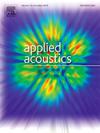有限截面波导中sh型导波的二维波结构分析
IF 3.4
2区 物理与天体物理
Q1 ACOUSTICS
引用次数: 0
摘要
有限截面构件广泛应用于基础设施建设中,如钢轨、扁钢等。传统的无限片理论无法描述有限截面波导中的波结构。本文对类sh导波的波结构进行了理论分析,结果表明在有限截面波导中存在二维波结构。基于波动有限元法和位移约束,得到了sh型导波在矩形板中的频散曲线。计算了类sh导波的二维波结构,分析了不同类sh导波模式下的粒子振动。采用多周期永磁电磁声换能器设计了不同模式的激励方式。生成了四种模式的类sh导波,并对实验信号进行频波数域分析,验证了不同模式的色散曲线。结果表明,实验信号的2DFFT结果部分偏离色散曲线,部分与色散曲线吻合较好。进一步研究表明,2DFFT结果的偏移是由于三维变形产生的强Lamb波,Lamb波与sh型导波的耦合形成了具有多个振动方向的耦合波。这些发现为理解有限截面波导中的波结构和利用类sh导波检测有限截面分量提供了基础。本文章由计算机程序翻译,如有差异,请以英文原文为准。
Two-dimensional wave structure analysis of SH-like guided waves in finite cross-section waveguide
Finite cross-section components are widely used in infrastructure construction, such as rail and flat steel. The traditional infinite plate theory cannot describe the wave structures in the finite cross-section waveguide. In this study, the wave structures of the SH-like guided waves are analyzed theoretically, which show that there are two-dimensional wave structures in the finite cross-section waveguide. Based on wave finite element method (WFEM) and displacement constraints, the dispersion curve for SH-like guided wave in a rectangular plate is obtained. The two-dimensional wave structures of SH-like guided waves are calculated, and the particle vibrations of different SH-like guided wave modes are analyzed. The excitation method of different modes was designed by using multiple periodic-permanent-magnet electromagnetic acoustic transducers (PPM EMATs). Four modes of SH-like guided waves are generated, and the frequency-wavenumber domain analysis of the experimental signals is carried out to verify dispersion curves of different modes. Results show that some 2DFFT results of experimental signals are offset from the dispersion curves, and some of them agree well with the dispersion curves. Further studies show that the offset of the 2DFFT results is due to the strong Lamb wave generated by the three-dimensional deformation, and the coupling of Lamb wave and SH-like guided waves forms a coupled wave with multiple vibration directions. These findings provide a basis for understanding the wave structures in finite cross-section waveguides and using SH-like guided waves to detect finite cross-section components.
求助全文
通过发布文献求助,成功后即可免费获取论文全文。
去求助
来源期刊

Applied Acoustics
物理-声学
CiteScore
7.40
自引率
11.80%
发文量
618
审稿时长
7.5 months
期刊介绍:
Since its launch in 1968, Applied Acoustics has been publishing high quality research papers providing state-of-the-art coverage of research findings for engineers and scientists involved in applications of acoustics in the widest sense.
Applied Acoustics looks not only at recent developments in the understanding of acoustics but also at ways of exploiting that understanding. The Journal aims to encourage the exchange of practical experience through publication and in so doing creates a fund of technological information that can be used for solving related problems. The presentation of information in graphical or tabular form is especially encouraged. If a report of a mathematical development is a necessary part of a paper it is important to ensure that it is there only as an integral part of a practical solution to a problem and is supported by data. Applied Acoustics encourages the exchange of practical experience in the following ways: • Complete Papers • Short Technical Notes • Review Articles; and thereby provides a wealth of technological information that can be used to solve related problems.
Manuscripts that address all fields of applications of acoustics ranging from medicine and NDT to the environment and buildings are welcome.
 求助内容:
求助内容: 应助结果提醒方式:
应助结果提醒方式:


